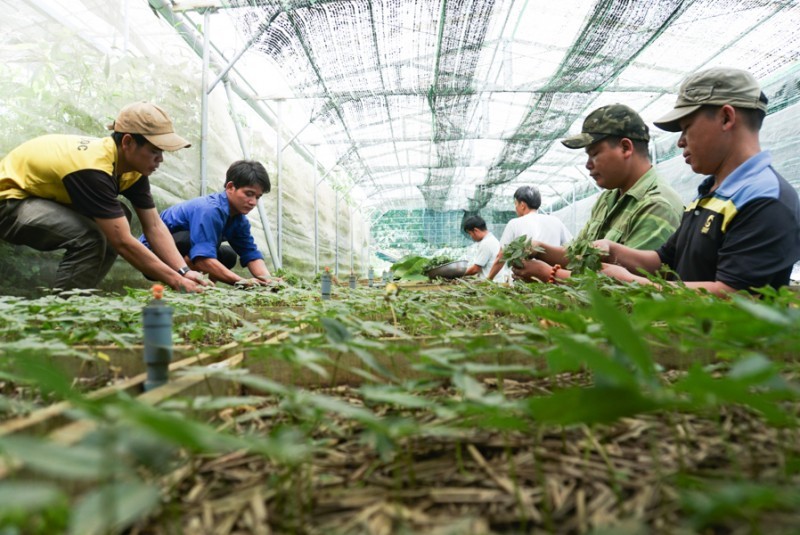Striving for the planting area of Vietnamese Ginseng to reach about 21,000 hectares by 2030
On June 1, 2023, the Prime Minister of Vietnam issued Decision 611/QD-TTg approving the Program to develop Vietnamese Ginseng to 2030, with orientation to 2045. (Program)

Striving for the planting area of Vietnamese Ginseng to reach about 21,000 hectares by 2030 (Internet image)
1. Striving for the planting area of Vietnamese Ginseng to reach about 21,000 ha by 2030
According to Decision 611/QD-TTg in Section II, Article 1, the goals of the decision on the Program to develop Vietnamese Ginseng to 2030 with orientation to 2045 are as follows:
- General objective:
Building and developing Vietnamese Ginseng into a commodity with high economic value, a key product in the fields of medicine - pharmacy, and health care, branded as a national product; contributing to creating jobs and incomes for people, socio-economic development in ethnic minority areas, and ensuring national defense and security.
- Detail goal:
+ The period up to 2030:
Conservation of Vietnamese Ginseng genetic resources in the wild in association with forest protection and development, biodiversity conservation in forest ecosystems;
Striving for the planting area of Vietnamese Ginseng to reach about 21,000 hectares by 2030, 100% of the growing area of Vietnamese Ginseng will be granted a planting area code and geographical indication.
The exploitation output of Vietnamese ginseng from 2030 will reach about 300 tons/year (the exploitation area is about 1,000 ha/year), ensuring the origin, meeting GACP-WHO standards (good farming and harvesting practices) ) or equivalent.
Investing in and building facilities for preliminary processing and deep processing of products from Vietnamese Ginseng associated with raw material areas, producing in chains, of which about 50% of production facilities meet GMP-WHO quality standards (good manufacturing practice).
- Orientation to 2045:
Developing Vietnamese Ginseng into an international branded commodity with high export value, creating an important source of income for localities, and striving to turn Vietnam into a major ginseng producer in the world.
2. Vietnamese Ginsengs that are preserved, planted, and developed
Objects of Vietnamese ginseng that are preserved, planted, and developed according to the provisions of Section III, Clause 2, Article 1 of Decision 611/QD-TTg include:
- Objects of conservation, development, processing, and commercialization on a commodity scale: Ngoc Linh ginseng (Panax vietnamensis Ha et Grushv), Lai Chau ginseng (Panax vietnamensis var. fiscidiscus K.Komatsu, S.Zhu & S.Q.Cai) ).
- Objects of conservation, cultivation, and development of experimental scale: Lang Biang Ginseng (Panax vietnamensis var. langbianensis N.V.Duy, V.T.Tran&L.N.Trieu) and Puxailaileng Ginseng (Panax sp) in an area with suitable natural conditions.
The planned land fund for planting and developing Vietnamese Ginseng for production and business purposes in this Program includes: planting and developing under the canopy of protection forests and production forests by the method of agroforestry production in accordance with the provisions of the law on forestry and agricultural land.
3. Main tasks of Vietnam Ginseng Development Program to 2030, orientation to 2045
According to the provisions of Section IV, Article 1 of Decision 611/QD-TTg, the main tasks are specified as follows:
- Conservation and development of Vietnamese Ginseng:
+ Evaluate Vietnamese Ginseng species distributed in natural forests in the following provinces: Quang Nam, Kon Tum, Gia Lai, Lam Dong, Thua Thien Hue, Nghe An, Lao Cai, Lai Chau, and Dien Bien on: distribution, species (genomic analysis), area, reserve, and proposed planting area fit.
+ Build an in situ conservation area and an ex situ collection garden of Vietnamese ginseng genetic resources in some typical ecological regions with natural distribution, with priority given to Quang Nam and Kon Tum provinces, Lam Dong, Nghe An, and Lai Chau.
+ Build a database system on the conservation and development of genetic resources for Vietnamese Ginseng species and identify suitable planting areas.
- Research, selection, creation, and production of Vietnamese ginseng varieties:
+ Research, select, and breed Vietnamese Ginseng, with a focus on selecting and creating Ngoc Linh and Lai Chau ginseng varieties with high yield, high quality, and resistance to pests and diseases.
+ Form modern seed production facilities in the localities on the basis of specific determination of the appropriate size and effectiveness of the Vietnamese Ginseng growing area; with priority given in the provinces of Quang Nam, Kon Tum, and Lai Chau, meeting the requirements of commodity production with the ability to supply seedlings for the development of raw materials on an average of about 2,000 ha/year.
+ Complete the seed production processes and the cultivation process of Vietnamese Ginseng in service of planting and developing raw material areas for production.
+ Build a quality management system, control the origin of Vietnamese Ginseng varieties to ensure legality according to current regulations.
…
(See more details in Section IV, Article 1 of Decision 611/QD-TTg)
Decision 611/QD-TTg takes effect from the date of signing and promulgation.
Nguyen Ngoc Que Anh
- Key word:
- Vietnamese Ginseng
- Number of deputy directors of departments in Vietnam in accordance with Decree 45/2025/ND-CP
- Cases ineligible for pardon in Vietnam in 2025
- Decree 50/2025 amending Decree 151/2017 on the management of public assets in Vietnam
- Circular 07/2025 amending Circular 02/2022 on the Law on Environmental Protection in Vietnam
- Adjustment to the organizational structure of the Ministry of Health of Vietnam: Certain agencies are no longer listed in the organizational structure
- Vietnam aims to welcome 22-23 million international tourists in Vietnam in 2025
-

- Notable new policies of Vietnam effective as of ...
- 16:26, 11/04/2025
-
.Medium.png)
- Notable documents of Vietnam in the previous week ...
- 16:21, 11/04/2025
-
.Medium.png)
- Notable documents of Vietnam in the previous week ...
- 16:11, 02/04/2025
-
.Medium.png)
- Notable new policies of Vietnam to be effective ...
- 16:04, 02/04/2025
-
.Medium.png)
- Notable new policies of Vietnam effective from ...
- 14:51, 21/03/2025
 Article table of contents
Article table of contents
